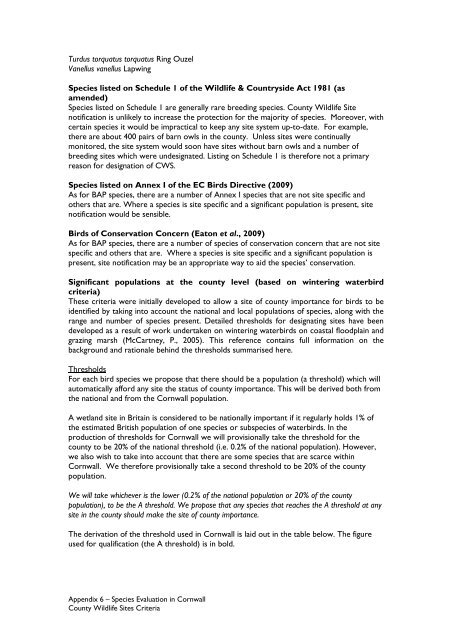County Wildife Site Criteria for Cornwall Appendices
County Wildife Site Criteria for Cornwall Appendices
County Wildife Site Criteria for Cornwall Appendices
You also want an ePaper? Increase the reach of your titles
YUMPU automatically turns print PDFs into web optimized ePapers that Google loves.
Turdus torquatus torquatus Ring OuzelVanellus vanellus LapwingSpecies listed on Schedule 1 of the Wildlife & Countryside Act 1981 (asamended)Species listed on Schedule 1 are generally rare breeding species. <strong>County</strong> Wildlife <strong>Site</strong>notification is unlikely to increase the protection <strong>for</strong> the majority of species. Moreover, withcertain species it would be impractical to keep any site system up-to-date. For example,there are about 400 pairs of barn owls in the county. Unless sites were continuallymonitored, the site system would soon have sites without barn owls and a number ofbreeding sites which were undesignated. Listing on Schedule 1 is there<strong>for</strong>e not a primaryreason <strong>for</strong> designation of CWS.Species listed on Annex I of the EC Birds Directive (2009)As <strong>for</strong> BAP species, there are a number of Annex I species that are not site specific andothers that are. Where a species is site specific and a significant population is present, sitenotification would be sensible.Birds of Conservation Concern (Eaton et al., 2009)As <strong>for</strong> BAP species, there are a number of species of conservation concern that are not sitespecific and others that are. Where a species is site specific and a significant population ispresent, site notification may be an appropriate way to aid the species’ conservation.Significant populations at the county level (based on wintering waterbirdcriteria)These criteria were initially developed to allow a site of county importance <strong>for</strong> birds to beidentified by taking into account the national and local populations of species, along with therange and number of species present. Detailed thresholds <strong>for</strong> designating sites have beendeveloped as a result of work undertaken on wintering waterbirds on coastal floodplain andgrazing marsh (McCartney, P., 2005). This reference contains full in<strong>for</strong>mation on thebackground and rationale behind the thresholds summarised here.ThresholdsFor each bird species we propose that there should be a population (a threshold) which willautomatically af<strong>for</strong>d any site the status of county importance. This will be derived both fromthe national and from the <strong>Cornwall</strong> population.A wetland site in Britain is considered to be nationally important if it regularly holds 1% ofthe estimated British population of one species or subspecies of waterbirds. In theproduction of thresholds <strong>for</strong> <strong>Cornwall</strong> we will provisionally take the threshold <strong>for</strong> thecounty to be 20% of the national threshold (i.e. 0.2% of the national population). However,we also wish to take into account that there are some species that are scarce within<strong>Cornwall</strong>. We there<strong>for</strong>e provisionally take a second threshold to be 20% of the countypopulation.We will take whichever is the lower (0.2% of the national population or 20% of the countypopulation), to be the A threshold. We propose that any species that reaches the A threshold at anysite in the county should make the site of county importance.The derivation of the threshold used in <strong>Cornwall</strong> is laid out in the table below. The figureused <strong>for</strong> qualification (the A threshold) is in bold.Appendix 6 – Species Evaluation in <strong>Cornwall</strong><strong>County</strong> Wildlife <strong>Site</strong>s <strong>Criteria</strong>
















